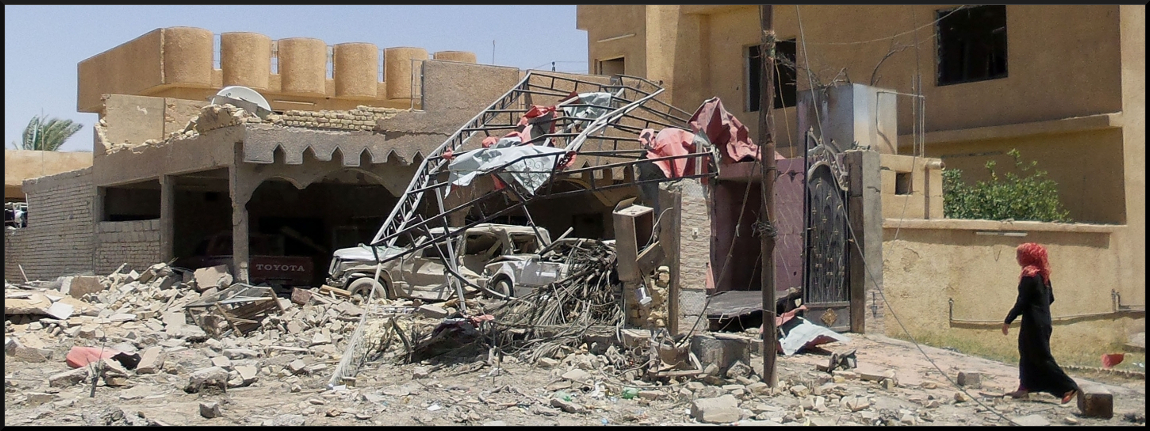by Janine Solanki of MAWO, originally published on The Fire This Time
On March 19, 2013 the U.S. began what infamously was known as “Shock and Awe” – a massive bombardment of Baghdad, Iraq. Images broadcast worldwide showed a city engulfed in explosions, glowing under the fire of continuous bombing. In the first 21 days of that vicious initial assault, over 1700 air sorties were conducted, resulting in 320 civilians killed each day according to Iraq Body Count.
This is how the invasion of Iraq began, and now we are marking 15 years of continued war and occupation carried out by the U.S. and their imperialist allies. Now over 1 million Iraqis have been killed as a result of the Iraq war, according to British polling group Opinion Research Business. Excuses and justifications from imperialist politicians for the war on Iraq have ranged from “war on terror” to “weapons of mass destruction”, and included claims of freeing Iraq from a dictator, and then from Daesh (aka ISIS) a terrorist group which in reality was a creation of the imperialist occupation. From the beginning until today, the whole war on Iraq has been based on lies, manipulation and deception, propagated through mainstream media outlets and rhetoric from politicians. All of this effort was met with opposition. Leading up to the war on Iraq, the largest mobilizations in human history took place, culminating with 12 – 14 million people worldwide in coordinated antiwar protest on February 15, 2003.
After 15 years of imperialist, U.S.-led war and occupation, what state is Iraq in today? The physical destruction of Iraq is massive, impacting electricity production and water treatment along with other vital infrastructure. By 2013, already 10 years after the U.S. invasion of Iraq, the country still had only 30% of the electricity production provided prior to the occupation, according to Iraq’s ministry of electricity. The war and occupation has also destroyed many critical institutions, including Iraq’s healthcare and education system, leading to sharp declines in almost every standard of living you can imagine. Before the 2003 invasion, school enrollment rates were nearly 100% and Iraq was renowned for having one of the best education systems in the Middle East. By 2006 only 30% of Iraq’s children were enrolled in school, and in 2016 UNICEF reported the nearly 3.5 million school-aged children in Iraq attend school irregularly, or not at all.
Among the many health-related statistics which have suffered under the occupation, the rates of cancer and birth defects are the most horrifying. The rate of cancer in Iraq has increased by 40 times, mainly resulting from the U.S. military’s use of depleted uranium, especially in the city of Fallujah. A study titled “Cancer, Infant Mortality And Birth-Sex Ratio in Fallujah, Iraq 2005-2009”, concluded that the dramatic rise in infant mortality, cancer and leukemia exceed those reported by survivors of the atomic bomb catastrophe in Hiroshima and Nagasaki.
As we approach International Women’s Day on March 8, we must remember how war and occupation impacts women especially. The U.S. war and occupation has left 1.6 million Iraqi women widows (United Nations Mission in Iraq – UNAMI, March 21, 2015) although some estimates are as high as 3 million. As women struggle to provide for their families and to survive, many have been forced into prostitution. Rates of rape and violence against women have risen under occupation, and the trafficking of women and girls for sexual slavery has also skyrocketed, with estimates in the tens of thousands.
Since the start of the war, the U.S. has employed the strategy of divide and conquer. Divisions based on different ethnic groups and religious institutions were implemented and enforced, especially within Iraq’s previously secular government which under U.S. occupation was divided up between ethnic and religious identities. Communities, neighborhoods and institutions which had been made up of mixed ethnic and religious groups were segregated and divided, and intermarriage between sects, which previously was a third of marriages, also dropped under U.S. occupation. After 15 years of U.S. intervention sowing animosity and infighting, civil war in Iraq continues.
After a decade and a half of war, an important question to ask is, why so much criminality and destruction? Since the U.S. lost her absolute hegemony over the Middle East following the Iranian Revolution of 1979, U.S. has been trying to find a way to regain complete hegemony in the region. The war on Iraq is part of a larger new era of war and occupation the U.S. has been conducting, which includes Afghanistan, Iraq, Libya, Yemen, Syria, Lebanon and Palestine, and has Iran within its central targets.
The crisis in Iraq is only deepening, with a large number of Iraqis making up what is now the largest refugee crisis the world has ever seen as a result of imperialist war and occupation. The only way forward from this crisis, to overcome infighting and rebuild Iraq, is for the U.S. and all imperialist forces to get out of Iraq. The people of Iraq are the force which has a vested interest in rebuilding their country, not any foreign or imperialist force. As the people of Iraq are fighting for their self-determination, peace-loving people around the world have the responsibility to echo and fight for this demand until all imperialist forces are out of Iraq.
Janine Solanki is an Antiwar and social justice activist, supporter of the Cuban Revolution and Fidelista! from Vancouver. She is a member of MAWO (Movement Against War and Occupation), Vancouver Follow Janine Solanki on Twitter: @janinesolanki
